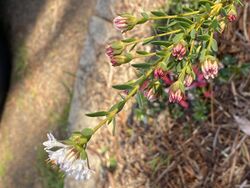Biology:Pimelea ciliata
| Pimelea ciliata | |
|---|---|

| |
| Scientific classification | |
| Kingdom: | Plantae |
| Clade: | Tracheophytes |
| Clade: | Angiosperms |
| Clade: | Eudicots |
| Clade: | Rosids |
| Order: | Malvales |
| Family: | Thymelaeaceae |
| Genus: | Pimelea |
| Species: | P. ciliata
|
| Binomial name | |
| Pimelea ciliata Rye[1]
| |
Pimelea ciliata, commonly known as white banjine,[2] is a species of flowering plant in the family Thymelaeaceae. It is a small shrub with white flowers and is endemic to Western Australia.
Description
Pimelea ciliata is a small shrub usually 0.5–1 m (1 ft 8 in–3 ft 3 in) high with almost linear or egg-shaped to narrowly obovate leaves, 5–22 mm (0.20–0.87 in) long, 1.5–7 mm (0.059–0.276 in) wide, margins sometimes rolled under or upward on a short petiole about 1 mm (0.039 in) long, ending with a pointed apex. The leaves are arranged in alternating pairs at right angles to the ones above and below so that the leaves are in 4 rows along the stems (decussate), upper surface is darker than the underside. The stems at the apex are orange-red to brownish becoming grey as they age. The erect inflorescence consists of several light pink or white bisexual flowers, smooth inside, pedicel 1–2 mm (0.039–0.079 in) long, four to six egg-shaped bracts, 8–13 mm (0.31–0.51 in) long, 5–10 mm (0.20–0.39 in) wide with small hairs on the edges. The flower stamens are marginally or greater in length than the sepals. Flowering occurs from August to December.[2][3]
Taxonomy
Pimelea ciliata was first formally described in 1984 by Barbara Lynette Rye in the journal Nuytsia.[3][4]
Distribution and habitat
White banjine grows in the south-west corner of Western Australia near Bindoon to near Margaret River and south-east to the Porongurup Range mostly on hills and breakaways in clay, sand, loam, granitic and lateritic soil.[2][3]
References
- ↑ "Pimelea ciliata". Australian Plant Census. https://biodiversity.org.au/nsl/services/apc-format/display/67100. Retrieved 25 October 2020.
- ↑ 2.0 2.1 2.2 "Pimelea ciliata". Department of Biodiversity, Conservation and Attraction. https://florabase.dpaw.wa.gov.au/browse/profile/5238. Retrieved 31 October 2020.
- ↑ 3.0 3.1 3.2 Rye, Barbara Lynette (1984). "Pimelea ciliata". Nuytsia 5 (1): 6. https://www.biodiversitylibrary.org/item/223585#page/9/mode/1up. Retrieved 31 October 2020.
- ↑ "Pimelea ciliata". Australian Plant Name Index. https://biodiversity.org.au/nsl/services/search?product=APNI&tree.id=&name=Pimelea+ciliata+Rye&inc._scientific=&inc.scientific=on&inc._cultivar=&inc._other=&max=100&display=apni&search=true. Retrieved 31 October 2020.
Wikidata ☰ {{{from}}} entry
 |


